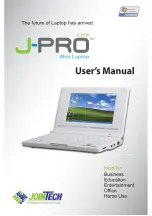
4-56
connecting the computer to a device that requires a bi-directional parallel signal.
Output
Activates uni-directional operation.
This is the default setting.
Bi-Directional
Activates bi-directional operation.
6.
Power Save Options
Use these options to increase the amount of time you can operate the T2200SX with battery
power.
(1)
CPU Sleep Mode
Use this option to enable or disable the CPU sleep mode. This option also appears in
the Pop-up Window.
When the AC adapter is connected to the computer and a wall outlet, this function is
automatically disabled. If you use a non-Toshiba MS-DOS operating system, you
must disable this option.
Enable
Enables the CPU sleep mode. The computer will automatically shift to
an operating speed of 5MHz when the processor is idle.
This is the default setting.
Disable
Disables the CPU sleep mode.
(2)
HDD Auto Off
Use this option to disable or set the duration of the HDD automatic power off func-
tion. This option also appears in the Pop-up Window.
When the AC adapter is connected to the computer and a wall outlet, this function is
automatically disabled. If you use a non-Toshiba MS-DOS operating system, you
must disable this option.
Disable
Disables HDD automatic power off.
This is the default setting.
xxMin.
Automatically turns off power to the HDD if it is not used for the
specified duration. The duration
(xx)
can be set to 3, 5, 10, 15, 20,
or 30 minutes.
(3)
Display Auto Off
Use this option to disable or set the duration of the display automatic power off
function. Setting this option conserves battery power because it causes the T2200SX
to turn the sidelight off if you don’t use the computer for the specified period of time.
This option also appears in the Pop-up Window.
Summary of Contents for T-Series T2200sx
Page 1: ...1 1 Chapter 1 Hardware Overview ...
Page 2: ...1 2 This page intentionally left blank ...
Page 4: ...1 4 This page intentionally left blank ...
Page 16: ...1 16 This page intentionally left blank ...
Page 17: ...2 1 Chapter 2 Operational Overview ...
Page 18: ...2 2 This page intentionally left blank ...
Page 43: ...3 1 Chapter 3 Troubleshooting Procedures ...
Page 44: ...3 2 This page intentionally left blank ...
Page 46: ...3 4 This page intentionally left blank ...
Page 82: ...3 40 This page intentionally left blank ...
Page 83: ...4 1 Chapter 4 Tests and Diagnostics ...
Page 84: ...4 2 This page intentionally left blank ...
Page 141: ...5 1 Chapter 5 Disassembly Procedures ...
Page 142: ...5 2 This page intentionally left blank ...
Page 144: ...5 4 This page intentionally left blank ...
Page 169: ...6 1 Chapter 6 Reassembly Procedures ...
Page 170: ...6 2 This page intentionally left blank ...
Page 172: ...6 4 This page intentionally left blank ...
Page 191: ...App 1 Appendices ...
Page 192: ...App 2 This page intentionally left blank ...
Page 196: ...App 6 Figure A 2 System board FSTFGx ICs back G G G G E F J H I K ...
Page 198: ...App 8 This page intentionally left blank ...
Page 200: ...App 10 Figure A 4 System board FSTFGx connectors back E A P Q ...
Page 202: ...App 12 This page intentionally left blank ...
Page 203: ...App 13 A 3 System Board FSTFGx OSCs Figure A 5 System board FSTFGx OSCs front F G H E ...
Page 204: ...App 14 Figure A 6 System board FSTFGx OSCs back A B C D ...
Page 215: ...App 25 Appendix C ASCII Character Codes Table C 1 ASCII character codes ...
















































